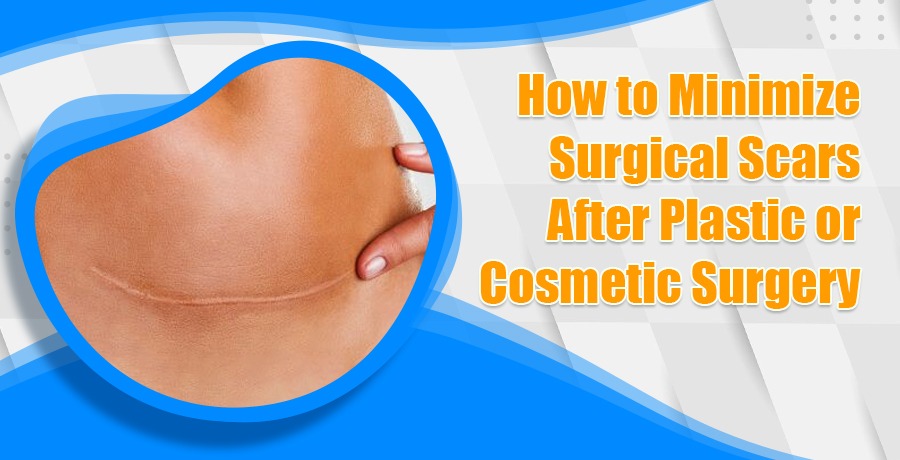
The concern of scarring is often the primary concern of patients planning to undergo plastic or cosmetic surgery . While scarring is a natural aspect of healing, the good news is that if you take precautions and your doctor employs the latest techniques, you can significantly reduce scarring as a result of surgery. This complete guide will take you through everything you need to know about scarring from pre-operative procedures to advanced scar removal treatments to guarantee you the best possible aesthetic outcome.
The Science of Scarring
When the skin is cut, the body responds by laying down collagen fibers to repair that wound. However, that wound repair tissue is never the same texture or quality as the surrounding skin and therefore becomes a scar. The ultimate appearance of a scar is dependent on the following factors already listed:
- Genetics: Some people are genetically predisposed to visible scars that are keloids or hypertrophic scars.
- Age: Younger skin appears to produce more collagen that is thicker (clinically this would be better as it produces less visible scarring)
- Skin Color: Some darker skin tones are more likely to develop visible scars.
- Location of Incision: Areas of high tension of the skin (ex. chest or shoulder) may be more visible.
- Surgical Technique: Your surgeon's technique is also important in limiting visible scarring.
Before the Blade: Pre-Operative Steps for Better Healing
Your road to minimal scarring starts way before you even enter the operating room. Here's what you can do:
- Choose a Board Certified Plastic Surgeon: An experienced surgeon will perform techniques that are designed to accurately position incisions inside the natural skin folds with suturing that minimizes tension, resulting in scars that are less noticeable.
- Maintain Your Health: A healthy body is more efficient at healing. In the weeks leading up to your surgery do everything you can eat a balanced diet that includes vitamins and protein, drink plenty of water, and sleep as much as you can.
- Quit Smoking: Smoking and nicotine products drastically impede blood flow which is very important for healing for your skin and body after surgery. Most surgeons will require you to quit smoking a few weeks before and after surgery to minimize complications including poor scarring.
The Healing Phase: Immediate Post-Operative Care is Crucial
The first several weeks after your surgery are the most important for healing your wound. Adhering to your surgeon's instructions carefully is essential!
- Keep it Clean: It is critical to properly care for your wound, especially to prevent infection which will only serve to make your scar worse. Follow your surgeon's specific directions for cleaning your incision site.
- Avoid Sun: A newly healed scar is very sensitive to UV rays! Sun exposure can darken and cause your scar to become more prominent. For at least the first year post-surgery, keep your incisions out of direct sunlight. You can protect them with clothing or a broad-spectrum sunscreen (30 SPF+) .
- Avoid Tension: Avoiding tension and stretching on your incision line is critical to proper wound healing. For a period of time recommended by your surgeon, you may need to refrain from certain movements and/or lifting heavy objects.
- Stay Hydrated and Nourished: Follow a healthy lifestyle to help support your body in healing.
Ways for Fading Scars
As your wound heals, you can use these long-term approaches to further improve the appearance of your scar:
- Silicone gels and sheets: Silicone has been shown to be one of the best topical scar treatment options. Silicone hydrates scar tissue, breaks down excess collagen production, and can help flatten and soften scars.
- Scar massage: Once your incision has fully closed, and your surgeon has given the go-ahead, then gentle massage of the scar can help break down the scar tissue, improve flexibility and lessen itching.
- Topical creams: There are some options that may be beneficial include creams containing ingredients like onion extract or vitamin E which are available over-the-counter. That said, the evidence is just not as great as silicone. Ensure that you talk to your surgeon before applying anything new to your scar.
When More is Needed: Advanced Scar Removal Treatment Options
For scars that remain noticeable despite diligent care, there are advanced treatments available. These options can significantly improve the appearance of scars, making them less visible.
- Surgical Scar Removal (Scar Revision Surgery): Often the best treatment option for larger or well defined scars is scar revision surgery. A surgeon will surgically remove the existing scar and close the incision with the latest surgical techniques to form a smaller and less noticeable scar. This is a very common and extremely successful method of surgical scar removal.
- Laser Treatments: Laser technologies can help improve scars differently. Some laser treatments can help reduce redness and pigment while others can flatten raised scars and improve scar texture.
- Steroid Injections: For thicker raised scars like hypertrophic scars or keloids, injections of corticosteroids can flatten this type of scar and decrease the redness or itching.
- Dermal Fillers: For depressed scars, or atrophic scars, injectable dermal fillers can be used to elevate the scar so it is level with the surrounding skin.
- Microneedling: Microneedling involves creating small punctures in the skin to improve collagen production, which can improve the texture of certain scars.
Your Next Step: Consultation with Dr. Anup Dhir
The key to achieving the best results and minimizing scarring is a personalized approach. If you are considering cosmetic surgery or are looking for effective scar removal treatment options, a professional consultation is your most important next step.
Dr. Anup Dhir is a renowned expert in the field of cosmetic and plastic surgery, dedicated to providing his patients with world-class care and exceptional aesthetic outcomes. During a one-on-one consultation, he will assess your individual needs, discuss your goals, and outline a tailored plan to ensure the most discreet and refined scarring possible.
The Final Word on Scar-Free Healing
While no procedure will be completely scar-free, modern surgical techniques and a commitment to careful aftercare can make those scars very hard to see. The way to get there is to be a part of the process. Choose a skilled surgeon, follow the post-operative instructions, and even explore other more advanced treatment options, and you will start enjoying your beautiful and natural results.
So let's get started in building your more confident self. Please get in touch with us today to schedule a consultation with Dr. Anup Dhir, and find out more about how you can get to your aesthetic goals with the least amount of mark.

